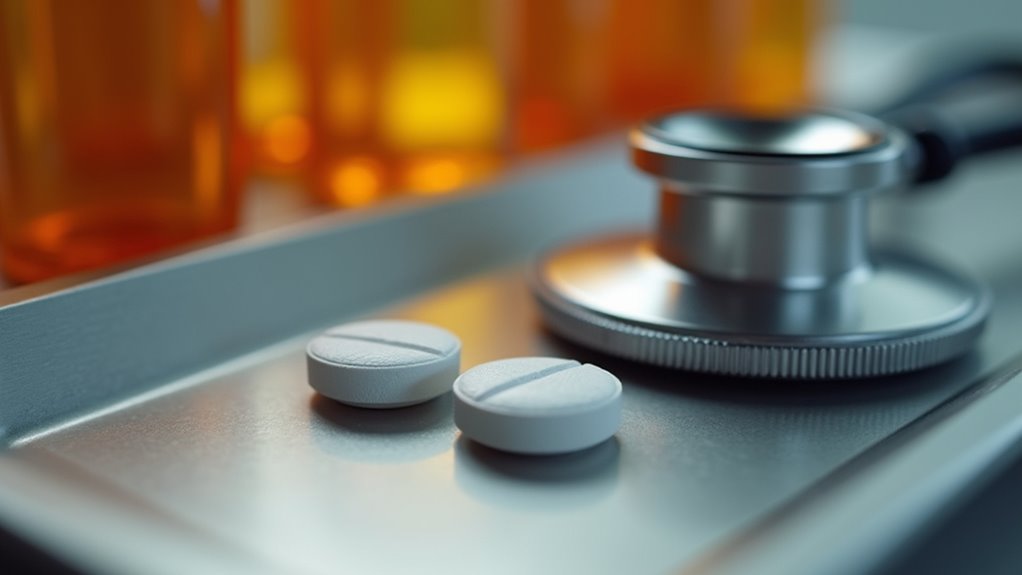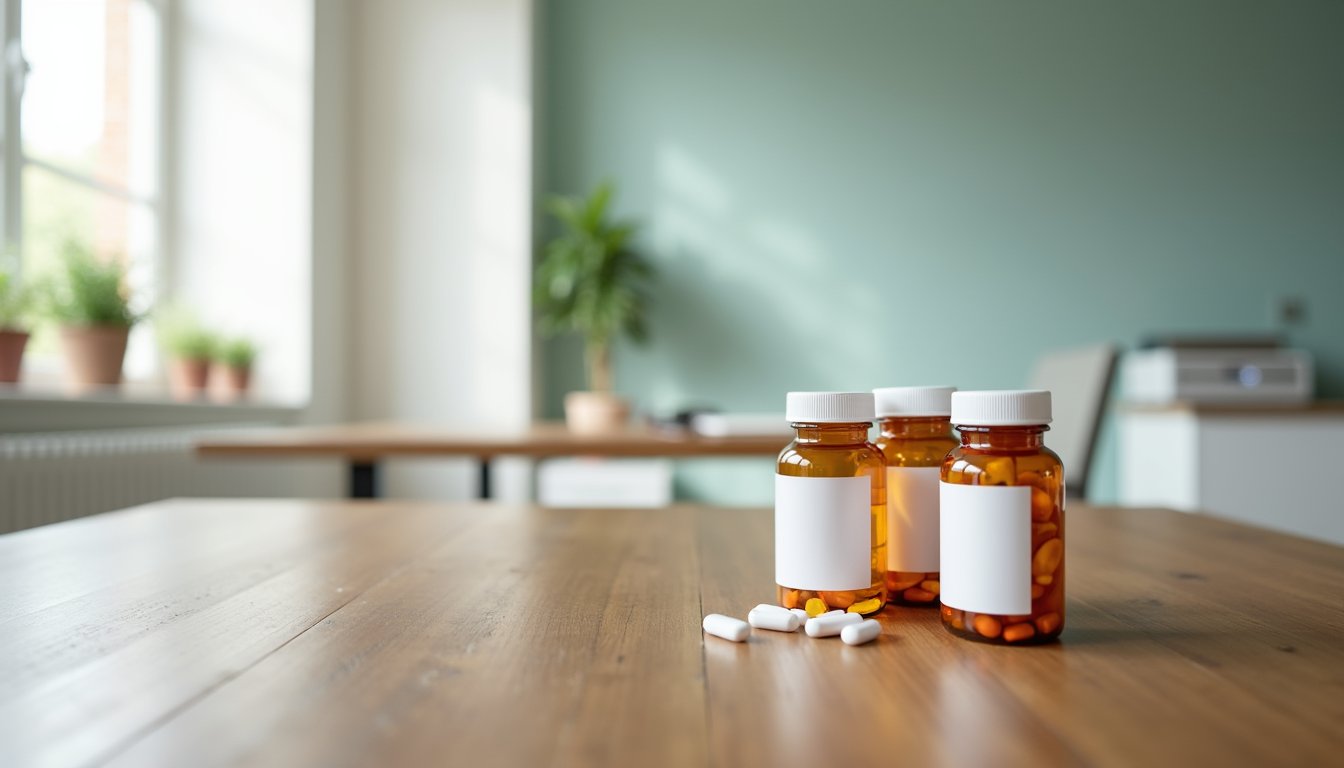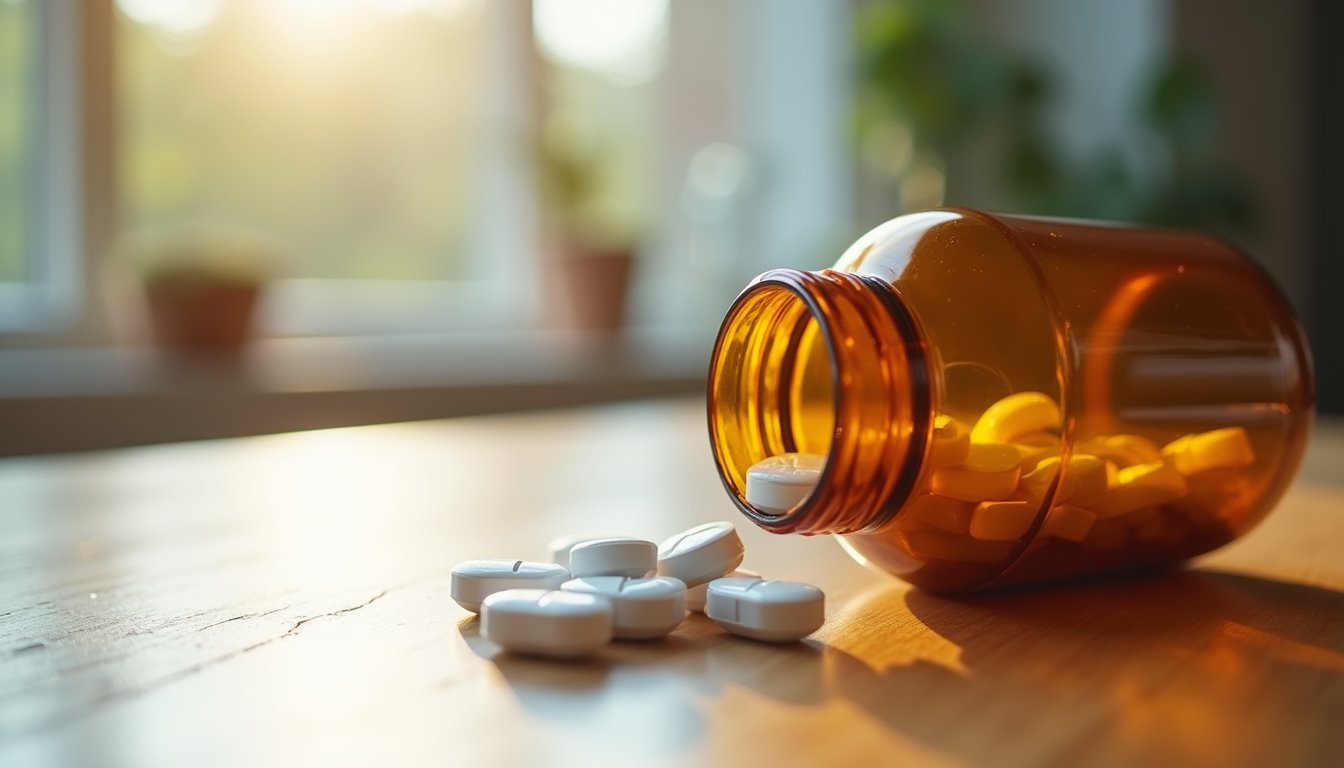In 2025, you’ll find five primary medications leading alcoholism treatment: naltrexone, acamprosate, disulfiram, gabapentin, and topiramate. Naltrexone stands out by reducing heavy drinking days up to 46%, while acamprosate increases abstinence rates to 36%. Your doctor might prescribe these medications alongside behavioral therapy for ideal results. Though only 2% of patients currently receive medication-assisted treatment, these evidence-based options offer proven pathways to recovery. Understanding each medication’s unique benefits can help guide your treatment choices.
The Role of Naltrexone in Modern Alcoholism Treatment

While numerous medications exist for treating alcohol use disorder (AUD), naltrexone has emerged as a primary pharmacological intervention with compelling evidence supporting its effectiveness. You’ll find it available in two forms: a daily oral pill or a monthly injectable version, both proven to reduce heavy drinking days by 38-46%. As an opioid receptor antagonist, it blocks alcohol’s rewarding effects in your brain. Only 2% of individuals with AUD received medication treatment in 2023, highlighting a significant treatment gap. The ADOPT study demonstrated that naltrexone initiated at hospital discharge effectively reduces heavy drinking in the following months.
Recent research indicates slightly higher adherence with injectable naltrexone compared to the oral form. You can receive naltrexone through targeted pre-drinking dosing using the Sinclair method, which shows 78% effectiveness, or opt for the monthly injection if you’re facing medication adherence challenges. When combined with counseling and medical management, it achieves impressive results, a 63.64% abstinence rate at three months. You’ll typically start treatment during hospitalization, continuing through outpatient care for ideal outcomes.
Understanding Acamprosate’s Impact on Sobriety
Looking for an effective medication to maintain sobriety? Acamprosate has proven to be a powerful tool in your recovery expedition. Clinical studies show it remarkably increases abstinence rates to 36% compared to 23.4% with placebo at six months, with its impact on craving reduction helping you stay alcohol-free. When combined with psychosocial interventions, acamprosate demonstrates enhanced effectiveness in preventing relapse. This medication is particularly valuable for patients with liver disease, as it has been shown to be safely metabolized even in those with compromised hepatic function.
You’ll find acamprosate particularly effective if you’ve already completed detox. It works by restoring your brain’s natural chemical balance disrupted by alcohol use. The medication extends mean abstinence duration to 224 days versus 163 days with placebo, and these long-term abstinence outcomes can persist up to a year after treatment ends. While diarrhea is the main side effect, acamprosate is generally safe, doesn’t cause addiction, and can be used alongside other medications, making it an excellent choice for ongoing sobriety maintenance. Studies have also shown that acamprosate produces cost-effective results while reducing long-term healthcare expenses associated with alcohol dependence.
Disulfiram: A Deterrent Approach to Alcohol Dependence

When considering medication-assisted treatment for alcohol dependence, disulfiram offers a unique deterrent approach by creating unpleasant reactions if you consume alcohol. The drug works by blocking aldehyde dehydrogenase, causing acetaldehyde buildup that triggers symptoms like nausea, flushing, and headaches when drinking. Studies show 400 million people are affected by alcohol consumption globally. Recent research published in Addiction Biology demonstrates the drug’s effectiveness as an adjunct treatment for severe cases.
While clinical studies show 50% of patients maintain sobriety for a year, daily administration challenges can limit its effectiveness. You’ll need strong motivation and supervision to succeed with this treatment. The medication doesn’t reduce cravings or address withdrawal but serves as a behavioral deterrent.
Limited utility for certain patients includes those with liver disease, heart conditions, or difficulty maintaining daily compliance. You’ll achieve the best results when combining disulfiram with all-encompassing behavioral therapy and strong social support systems.
Gabapentin’s Emerging Position in AUD Management
Unlike disulfiram’s deterrent mechanism, gabapentin offers a different therapeutic approach for alcohol use disorder (AUD) through its direct effects on brain chemistry. You’ll find gabapentin’s impact on alcohol withdrawal particularly notable, as it stabilizes the brain’s hyperexcitable state by increasing GABA and decreasing glutamate levels. Healthcare providers must monitor medication discontinuation carefully to prevent withdrawal effects. Sleep quality improvements are significant, with gabapentin showing reduced sleep disturbances and increased sleep efficiency without causing daytime drowsiness.
Studies show gabapentin’s influence on relapse risk is significant, with doses of 900-1800mg daily improving abstinence rates and reducing heavy drinking episodes. You’ll see better outcomes in patients with severe withdrawal symptoms, achieving 41% abstinence compared to 1% with placebo. The medication’s minimal liver metabolism makes it especially suitable if you’re treating patients with liver disease. While not FDA-approved for AUD, gabapentin’s safety profile and effectiveness in managing both withdrawal and relapse prevention make it a valuable treatment option. Recent clinical trials demonstrate that double-blind studies confirm gabapentin’s efficacy when combined with regular medical management visits.
Topiramate as an Alternative Treatment Option

As research continues to expand treatment options for alcohol use disorder, topiramate has emerged as a promising pharmacological intervention through its unique multi-neurotransmitter mechanism. Research shows that effects diminish substantially after discontinuing the medication, highlighting the importance of maintaining treatment. Evidence from systematic reviews demonstrates topiramate’s efficacy compared to other pharmacotherapies for AUD.
When considering topiramate, you’ll need to evaluate several key factors:
| Patient Selection Factors | Dosage Considerations |
|---|---|
| Compensated liver function | Begin 25-50mg daily |
| AUDIT score >8 | Titrate up to 400mg/day |
| No advanced cirrhosis | Monitor side effects |
You’ll find topiramate most effective during active treatment, with clinical trials showing significant reductions in heavy drinking days (-6.2%) and drinks per drinking day (-2.0). While it’s not FDA-approved for AUD, it’s particularly useful when primary treatments aren’t suitable. Remember to watch for common side effects like paresthesia, cognitive impairment, and weight loss, and implement slow titration protocols to minimize adverse reactions.
Comparing Effectiveness Among Available Medications
The effectiveness of FDA-approved medications for alcohol use disorder varies considerably based on patient characteristics and treatment goals. Comparative effectiveness data indicate that naltrexone and acamprosate demonstrate similar success rates, with both medications helping to reduce heavy drinking days and increase abstinence. You’ll find that oral naltrexone requires 10-12 patients to be treated for one to benefit, while acamprosate’s number needed to treat is around 12 for improved abstinence. Studies show that oral naltrexone specifically achieves a 38 percentage point reduction in heavy drinking.
Medication adherence impacts treatment outcomes tremendously, particularly with disulfiram, which works best under supervised administration. When you’re considering treatment options, it is crucial to note that combining medications with therapy produces better remission rates than either approach alone. The latest research suggests that newer options like semaglutide may offer additional benefits, though it is not yet FDA-approved for this use.
Integrating Medication Options With Recovery Programs
Most successful alcohol use disorder treatment programs integrate FDA-approved medications with detailed behavioral interventions. You’ll find that combining medications like naltrexone, acamprosate, or disulfiram with structured counseling greatly improves your chances of long-term recovery. Treatment providers focus on tailoring medications to individual needs while addressing any co-occurring mental health conditions.
Your recovery plan should include cognitive-behavioral therapy, motivational enhancement, and support groups to reinforce medication benefits. You’ll work with healthcare providers who’ll integrate mental health treatments when needed, ensuring both your alcohol use and underlying issues are addressed. Digital tools and mobile applications can help you track your progress and maintain medication adherence. Consistent medical follow-ups and aftercare planning are essential components that’ll support your ongoing recovery pathway.
Frequently Asked Questions
What Are the Typical Insurance Coverage Rates for Alcoholism Medications?
You’ll find high coverage rates for standard alcoholism medications, with 69-81% of private insurance requests and 92% of Medicaid claims being approved. Your copay structures typically range from $0-50 monthly for oral medications like naltrexone and acamprosate. However, you’ll need to navigate prior authorization requirements, especially for injectable options like Vivitrol. Be aware that off-label treatments have variable coverage, and newer options like semaglutide rarely receive insurance approval for alcoholism treatment.
How Do These Medications Interact With Common Prescription Antidepressants?
When you’re taking both alcoholism medications and antidepressants, you’ll find most combinations are safe, but there are critical considerations. Naltrexone and acamprosate generally work well with SSRIs and SNRIs, with minimal interactions. However, you’ll need extra caution with disulfiram combinations due to potential hepatotoxicity risks. Your doctor should monitor you for serotonin syndrome, especially if you’re on multiple serotonergic medications. Regular liver function testing is essential when combining these treatments.
Can Pregnant Women Safely Use Any Alcoholism Treatment Medications?
You’ll need to be extremely cautious with alcoholism medications during pregnancy, as none are proven completely safe. While preventing fetal alcohol syndrome risks is vital, current FDA-approved medications (naltrexone, acamprosate, and disulfiram) should be avoided unless absolutely necessary. Instead, you should focus on behavioral therapy and support groups as your initial treatment. If you’re concerned about postpartum depression treatment later, discuss this with your doctor to develop an extensive care plan.
What Percentage of Patients Experience Severe Side Effects From These Medications?
Based on clinical data, you’ll find that severe side effects are relatively rare across all major alcoholism medications. While medication efficacy remains high, severe adverse reactions occur in only 1-2% of patients using naltrexone, less than 1% with acamprosate, 2-5% with disulfiram, and under 2% with gabapentin or topiramate. Long-term safety studies show most side effects are mild to moderate, with serious complications requiring discontinuation occurring in less than 3% of cases.
Are There Genetic Markers That Predict Which Medication Will Work Best?
Yes, there are some genetic markers that can predict medication response, but they’re not routinely tested in clinical practice yet. Your genetic predisposition factors, particularly the OPRM1 variant, may indicate better response to naltrexone, while GRIK1 variations could suggest better outcomes with topiramate. While personalized treatment approaches based on genetics show promise, as of 2025, doctors still primarily rely on your clinical symptoms, medical history, and individual preferences when selecting medications.





